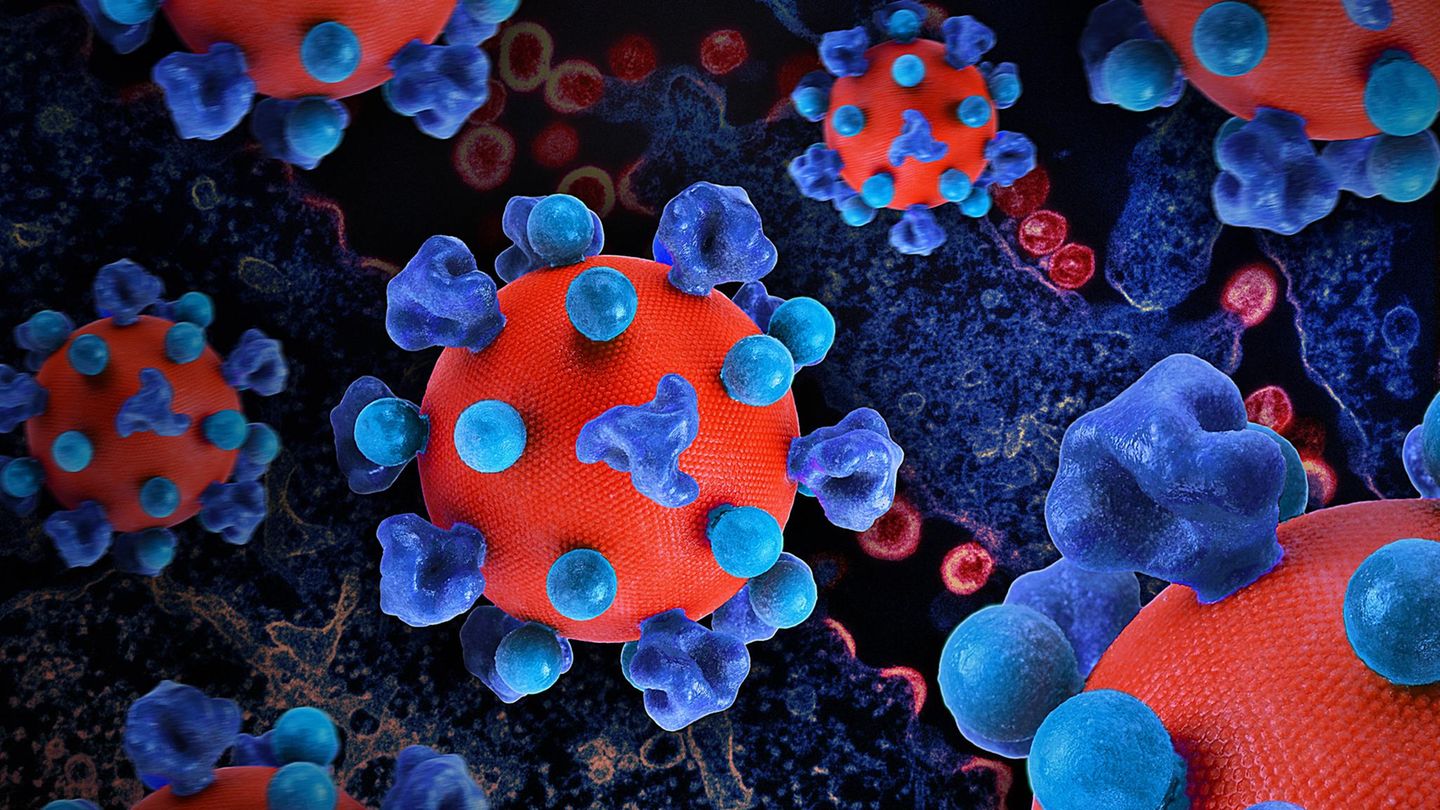Protection against AIDS
Is the vaccination against HIV? New study is careful hope of
Copy the current link
Add to the memorial list
To date, an effective HIV vaccination against the versatile AIDS virus is missing. A new study on primates currently gives rise to hope. The most important questions and answers.
For the younger generation with us, HIV/AIDS could appear like a problem for her parents or even grandparents. But the virus discovered in 1983 is still a scourge, especially in poorer regions of the world. Almost 40 million people currently live with an HIV infection. And over 600,000 still die every year from the consequences of AIDS. The problem continues in Germany too: Around 97,000 people with us have an HIV infection, more than 8000 do not even know that they are carrying the virus. They are not treated accordingly.
Compared to the first years of this pandemic, however, the therapy options are enormous today: for almost all infected people, the virus is able to suppress the virus so far that the available detection methods can no longer be found. However, the pathogen is not away. Discontinuation of the medication usually leads to the immediate increase in virus load. It would therefore be ideal if people were not infected and were reliably protected – for example by vaccination. But the way to such a prevention is difficult, even if a new study now gives hope.
Why is the development of vaccines against the Hi virus (HIV) so difficult?
The first obstacle is a kind of camouflage cap that envelops the virus: experts speak of a “glycan sign” that encloses the dangerous core of the pathogen with sugar molecules and thus protects against attacks by the immune system of the infected. As a result, HIV is a “enveloped virus”, influenza, the Corona virus Sars-Cov-2 or Ebola are more. But vaccine researchers can now avoid this. The decisive obstacle is the extraordinarily high versatility of HIV.
Our immune system reacts to an infection with a quick but less precise defense. Mostly only days later, accurate “specific” antibodies are followed by genetically, but can be ineffective due to mutations of the pathogen. In Corona pandemic, there was therefore often talk of the “immune flight” of the virus. If a virus like HIV also mutates very quickly, the immune system can hardly keep up with this development. This is all the more true than the hi virus does not any Body cells attacked, but the immune system itself.
Due to a vaccination, antibodies produced should be genetically positioned so that they can get very many, preferably even all variants of the virus. That is why the development of HIV vacancies is so challenging. As the US AIDS researcher and former director of the “National Institute of Allergy and Infectious Diseases” Anthony Fauci once put it, an HIV vaccine “has to cause an immune response that is better than a natural. And that is difficult to make.”
What attempts to vaccine have there were at HIV?
Initial clinical studies with thousands of volunteers were already in the United States, Europe and Thailand in the 1990s. At that time, a surface protein from HIV with the name “GP120” should create suitable antibodies against the virus in the vaccinated. But this approach failed. The vaccines neither protected the vaccines nor helped to slow down or mitigate at least the course of an infection. After these failures, HIV vaccine research focused on a more complex approach. It was not enough to trigger the production of a certain variety of specific antibodies.
Now the research of the researchers also focused on so-called “T cells” in our immune system, which, for example, recognize and destroy sick cells in our body or at least trigger alarm and ensure that. However, attempts that rely solely on the “cellular defense” did not lead to success. It was only in 2009 that the combination of two vaccines ineffective alone managed to get a step further and to reduce the risk of HIV infection among Thai volunteers by about a quarter. This was by no means enough for a broad application, but showed that a more complex procedure at least opened the chance of an effective vaccine.
Which path was chosen in the study now published?
Above all, to be more complex means to penetrate the “factories” of the immune system deeper and deeper. This should be made familiar with the Hi virus from scratch so that it can set up its lines of defense broadly and effectively. It is not surprising that this difficult undertaking is sometimes talking about the “grail” of vaccination science.
Antibodies that were found for the first time in infected people in the 1990s and develop for years are particularly interesting: so -called “Bnabs”. This is the abbreviation of the English name “Broadly neutralizing antibodies”. So it is antibodies that can make a more or less wide variety of hi viruses harmless. However, such immune-multitalists are extremely rare. If you want to use it for a vaccine, your production must be artificially stimulated.
For the study now published, antibodies were “trained” so that they were able to take advantage of a weak point in the most outstanding point in the virus shell. Because both the tip of a mountain as well as that of the heart muscle or a virus in Latin (and English) “apex” is called, this outstanding part of the HIV cover is also called “Apex”. It is exciting because it changes little genetically and the BNABs therefore do not have to be excessively “wide” in order to be able to effectively attack hi viruses at this point.
For the study, 24 healthy Rhesus-Makaken (closely with the Pavian primates) were vaccinated twice at a distance of eight weeks. For the vaccine test, APEX proteins of the HI virus have been changed in terms of genetic engineering so that they were more noticeable for the immune system of the vaccinated monkeys than the original on the virus cover-to create good conditions for the production of the desired antibodies with a broad effect. It was clear to the team from the start that this vaccination could only be something like an initial spark. After a certain time of maturation, this should follow a booster to further increase the production of the antibodies directed against HIV (the “Bnabs”).
How good were the results and what’s next?
In fact, the vaccination was able to start the production of the desired antibodies against “APEX” proteins. That alone is a success. In animal experiments with the macaques, the first neutralizations were even shown, so antibodies were created that could make hi viruses harmless. Fully mature antibodies with a wide range of effects have not yet been produced. From the outset, however, it was clear to the team that this new vaccine was only a first step. Above all, he should show that the principle works and is expandable. In addition, the approach worked not only in theory or in the petri dish, but also for primates from the other relationship between man. The vaccinations generated a strong immune response in all Rhesus makers. Preliminary cells were detected for the desired broad antibodies.
In short: the path to a vaccine that works alone or in combination with vaccines that are aimed at other goals of the virus and can eventually go to people in clinical attempts. The question of how far this way is could not yet be answered. In view of similar attempts to vaccine, at least ten years are expected to an effective, broadly available HIV vaccine. But as if the scientific hurdles are not already high, there are now massive political: the US government, the bottom of Donald Trump, recently stroked the renowned and significantly involved in this study “Consortium for HIV/AIDS Vaccine Development” in the amount of more than $ 250 million annually.
Source: Stern
I’m Caroline, a journalist and author for 24 Hours Worlds. I specialize in health-related news and stories, bringing real-world impact to readers across the globe. With my experience in journalism and writing in both print and online formats, I strive to provide reliable information that resonates with audiences from all walks of life.





